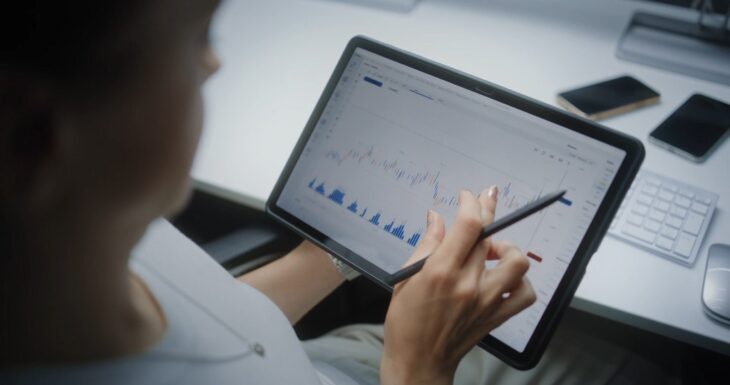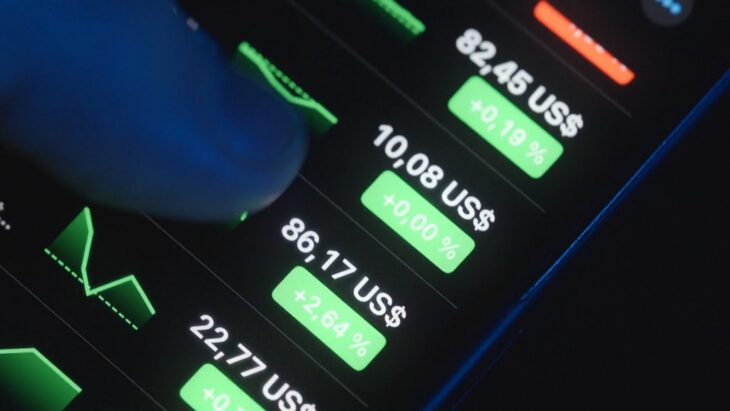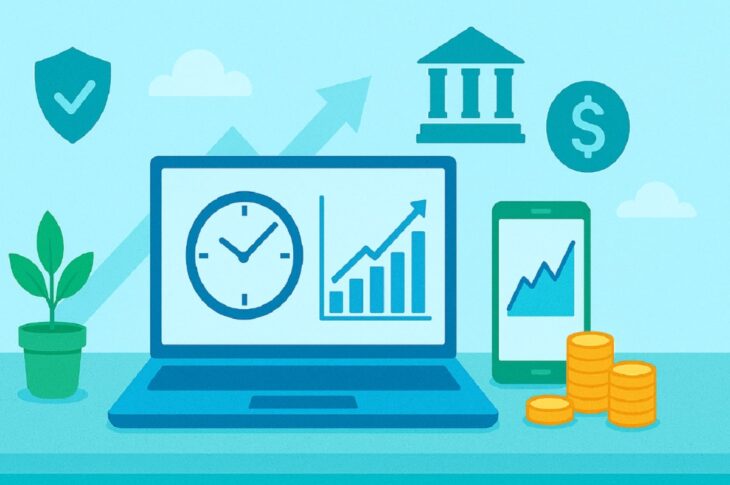Long-term investment strategies are changing because digital tools have made investing faster, smarter, and more accessible. In the past, an investor needed a broker, quarterly reports, and lots of manual tracking.
Today, apps and platforms powered by automation, AI, and blockchain can build diversified portfolios, stress-test them under different market conditions, and even allow fractional ownership of real estate or art.
The result is that investors can set up strategies that are not only more data-driven and transparent but also more resilient over decades.
The key point is this: digital tools eliminate barriers and bring institutional-grade strategies to everyday investors.
The Rise of Automated Portfolios

In the past, long-term investors often worked through brokers or tracked their holdings on spreadsheets. Adjustments happened slowly, sometimes just once a year during a meeting with a financial advisor. The downside was clear: manual processes left portfolios vulnerable to emotional decision-making.
Digital automation has transformed this reality. Robo-advisors like Betterment, Vanguard Digital Advisor, and Wealthfront automatically rebalance portfolios to match risk tolerance and time horizon.
They also incorporate tax-loss harvesting, which means selling underperforming assets to offset gains, lowering annual tax bills.
For long-term investors, this automation achieves three things:
- Consistency – rebalancing happens on schedule, regardless of market noise.
- Tax efficiency – automatic adjustments can boost after-tax returns over decades.
- Discipline – investors are shielded from rash moves driven by fear or greed.
In other words, automation doesn’t just save time; it protects the investor from themselves – a crucial advantage in long-term wealth building.
Real-Time Information as a Safety Net

Long-term strategies depend on steady progress, but risks emerge quickly. In earlier decades, investors had to rely on quarterly statements or delayed financial reports. By the time they saw trouble, it was often too late.
Today, platforms provide real-time dashboards that track exposure across sectors, asset classes, and even macroeconomic factors like interest rates and inflation. Investors can log in and see how their portfolio might respond to rising oil prices, currency shifts, or geopolitical disruptions.
Importantly, real-time analytics aren’t just about trading fast – they are about spotting structural risks early. For example, if an investor notices their portfolio is heavily weighted toward tech during a period of regulatory crackdown, they can adjust before small risks become big ones.
For the long-term investor, this level of visibility provides a safety net.
Breaking Borders: Global Access for Everyone

Diversification is a timeless principle of investing: spread your money across different regions and industries so no single downturn wipes you out. Before the digital era, this was easier said than done. Buying international equities or bonds often requires specialist brokers and high fees.
Now, global access is a few clicks away. Platforms like Interactive Brokers, Fidelity, and eToro allow retail investors to hold stocks from Europe, Asia, Africa, and Latin America with ease.
Exchange-traded funds (ETFs) make it possible to invest in dozens of countries at once.
| Factor | Before Digital Platforms | With Digital Tools Today |
| International access | Expensive, limited to institutions | Low-cost, accessible to retail investors |
| Emerging markets | Difficult to enter | ETFs available with fractional shares |
| Currency exposure | Hard to manage | Integrated hedging tools |
| Portfolio balance | Often skewed to the “home country” | Simple global diversification options |
For long-term investors, global diversification is no longer a challenge reserved for the wealthy – it’s an everyday reality that strengthens portfolios against domestic shocks.
Personalization: Aligning Portfolios With Life Goals
A successful long-term strategy is never just about maximizing returns; it’s about aligning money with life milestones. This is where digital financial planning tools have become indispensable.
Apps like Personal Capital, Mint, or YNAB connect directly to brokerage accounts and model out retirement timelines, tax projections, and lifestyle choices. They can simulate questions such as:
- What happens if inflation averages 3% for the next 20 years?
- How does retiring five years earlier affect my savings?
- How will healthcare costs impact my drawdown strategy?
These personalized insights turn investing into something tangible. Instead of staring at abstract growth percentages, investors can see whether they are still on track to retire at 60 or fund a child’s education.
This integration of personal goals into portfolio planning ensures that long-term investing remains grounded in real life.
Digital Risk Management: Preparing for the Next Crisis

Every long-term investor eventually faces downturns. The 2008 financial crisis, the 2020 pandemic shock, and countless smaller corrections are proof that the market will test even the most patient saver. Traditionally, only institutional investors had access to advanced risk simulations.
Today, risk management tools like Portfolio Visualizer or Riskalyze are available to individuals.
These platforms stress-test portfolios under historic conditions, asking: What would happen to my investments if another 2008 event struck tomorrow?
The value of these tools lies not in predicting the future, but in revealing vulnerabilities:
- Overexposure to equities in a downturn
- Weak hedging against inflation
- Insufficient diversification in defensive assets
By acting on these insights, investors can strengthen their portfolios before crises occur, instead of scrambling to recover afterward.
Digital Assets: A Revolution in Accessibility
Perhaps the most revolutionary change in long-term investing is the rise of tokenized assets. Using blockchain technology, traditional investments like real estate, private equity, or fine art can be fractionalized into digital tokens.
This lowers barriers dramatically. Instead of needing $100,000 to enter a property deal, an investor can participate with $500. Tokenization also improves liquidity: while traditional real estate might lock capital for years, tokenized versions can often be traded on digital exchanges.
| Asset Type | Traditional Model | Tokenized Model | Long-Term Benefit |
| Real Estate | High entry cost, illiquid | Fractional tokens, exchange trading | Accessible, flexible diversification |
| Private Equity | Limited to accredited investors | Available in fractional form | Democratized access to growth assets |
| Fine Art | Requires millions in capital | Shared digital ownership | Adds stability to diversified portfolios |
For long-term investors, tokenized assets combine the solidity of real-world investments with the flexibility of digital finance. They represent one of the clearest examples of how technology creates entirely new strategies for wealth-building.
ESG Integration: Data That Reduces Hidden Risks
Environmental, Social, and Governance (ESG) investing has exploded in recent years, but digital tools have made it more actionable. Platforms now provide detailed ESG scores, carbon impact metrics, and governance risk profiles directly alongside financial data.
This means long-term investors can align portfolios with personal values without compromising returns. More importantly, companies with poor ESG ratings may face lawsuits, regulatory fines, or reputational damage in the future.
By integrating ESG data, digital platforms help investors avoid these long-term pitfalls.
Artificial Intelligence: The Next Layer of Strategy

The final frontier in digital investing is artificial intelligence (AI). Already, AI tools scan millions of data points from earnings calls, government reports, and social media sentiment. They identify risks and opportunities far faster than human analysts.
For long-term strategies, AI isn’t about chasing short-term gains but about building adaptive portfolios.
For example, AI can highlight when inflationary risks are building across multiple markets or when new industries are gaining early traction. Over decades, this extra layer of intelligence keeps portfolios one step ahead of structural change.
Conclusion
The essence of long-term investing hasn’t changed: commit early, diversify widely, and stay disciplined. What has changed is how investors execute those principles. Digital tools automate the boring but essential parts of strategy, give real-time insight into risks, and open doors to entirely new asset classes through tokenization.
The future of long-term investing will belong to those who combine human judgment with digital precision. Those who embrace these tools today will not only grow wealth more efficiently but also ensure their portfolios remain resilient in the face of uncertainty.



